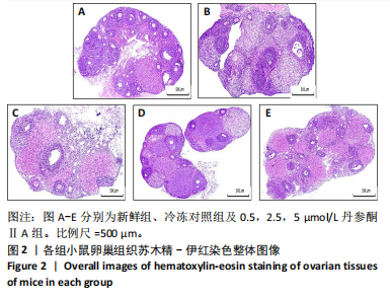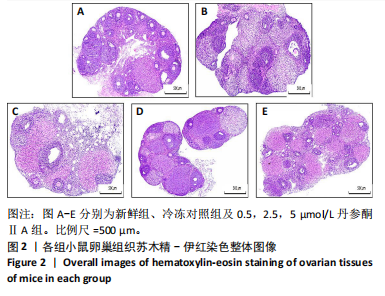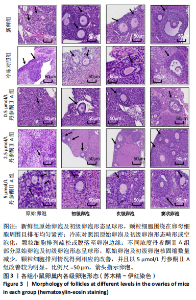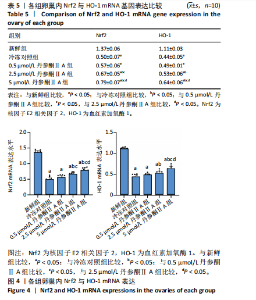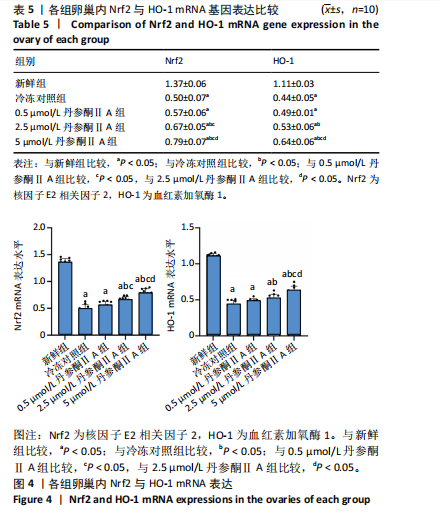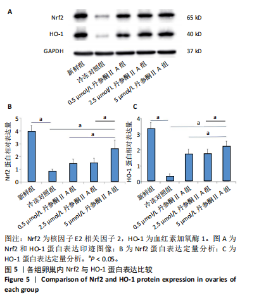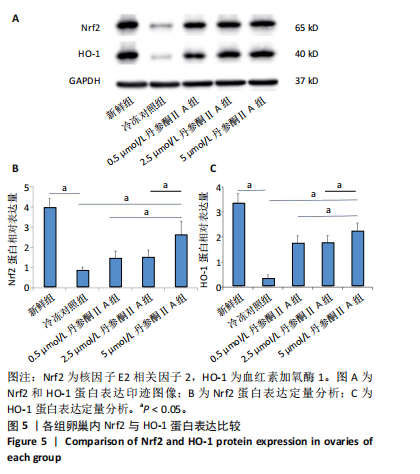Chinese Journal of Tissue Engineering Research ›› 2025, Vol. 29 ›› Issue (29): 6198-6204.doi: 10.12307/2025.776
Previous Articles Next Articles
Protective mechanism of tanshinone IIA in mouse ovarian cryopreservation
Wu Xiaochou1, Wang Huiying1, Wang Jie1, Zhang Caifeng1, Hou Yanyun2, Jin Bo1
- 1Department of Gynecology, 2Department of Pathology, Shenzhen Hospital of Beijing University of Chinese Medicine (Longgang), Shenzhen 518000, Guangdong Province, China
-
Received:2024-08-09Accepted:2024-10-08Online:2025-10-18Published:2025-03-06 -
Contact:Jin Bo, MD, Associate researcher, Department of Gynecology, Shenzhen Hospital of Beijing University of Chinese Medicine (Longgang), Shenzhen 518000, Guangdong Province, China -
About author:Wu Xiaochou, MS, Physician, Department of Gynecology, Shenzhen Hospital of Beijing University of Chinese Medicine (Longgang), Shenzhen 518000, Guangdong Province, China -
Supported by:Shenzhen “Top Three Medical and Health Projects”, No. SZZYSM202311019 (to WHY); Medical and Health Technology Research Project in Longgang District of Shenzhen, No. LGKCYLWS2023002 (to WHY); Medical and Health Technology Plan Project of Shenzhen Science and Technology Innovation Bureau, No. LGKCYLWS2021000019 (to WHY); Yulong Plan-Sanlong Talent Project, No. 2023-BUCMSZYLRC13 (to WXC); Shandong Yinfeng Life Science Research Project, No. KJKHX2023001 (to WHY)
CLC Number:
Cite this article
Wu Xiaochou, Wang Huiying, Wang Jie, Zhang Caifeng, Hou Yanyun, Jin Bo. Protective mechanism of tanshinone IIA in mouse ovarian cryopreservation[J]. Chinese Journal of Tissue Engineering Research, 2025, 29(29): 6198-6204.
share this article
Add to citation manager EndNote|Reference Manager|ProCite|BibTeX|RefWorks
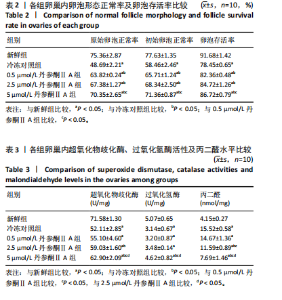
2.1 玻璃化冷冻液中添加丹参酮ⅡA对小鼠卵巢各级卵泡的影响 由图2,3可见,新鲜组卵巢内原始卵泡及初级卵泡形态呈球形,颗粒细胞围绕在卵母细胞周围且排布均匀紧密;冷冻对照组卵巢内原始卵泡及初级卵泡形态畸形或空泡化,颗粒细胞排列疏松或脱落至卵泡边缘;不同浓度丹参酮ⅡA组卵巢内部分原始卵泡及初级卵泡形态呈球形,原始卵泡及初级卵泡核固缩数量减少,颗粒细胞排列疏松或脱落至卵泡边缘情况也得到相应的改善,并且以5 μmol/L丹参酮ⅡA组改善较为明显。 如表2所示,与新鲜组相比,其他4组卵巢内各级卵泡正常率与卵泡存活率均显著下降(P < 0.05);与冷冻对照组相比,不同浓度丹参酮ⅡA组卵巢内各级卵形态正常率与卵泡存活率均显著升高(P < 0.05),并与丹参酮ⅡA浓度呈正相关性,尤其以5 μmol/L丹参酮ⅡA组升高较为显著。 2.2 各组卵巢内超氧化物歧化酶、过氧化氢酶活性及丙二醛水平比较 氧化损伤是导致卵巢低温冻存后活性降低的主要因素之一,其中超氧化物歧化酶、过氧化氢酶及丙二醛是反映卵巢组织氧化应激的重要指标。如表3所示,与新鲜组相比,其他4组卵巢内超氧化物歧化酶及过氧化氢酶活性均显著降低(P < 0.05),丙二醛水平显著升高(P < 0.05);与冷冻对照组相比,不同浓度丹参酮ⅡA组卵"
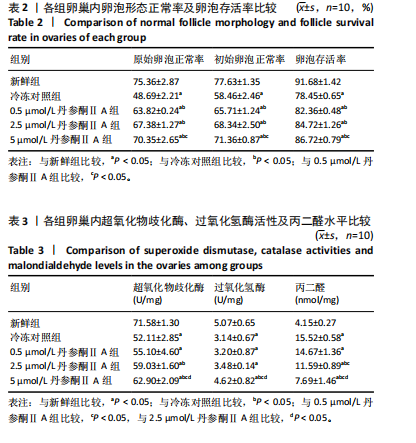
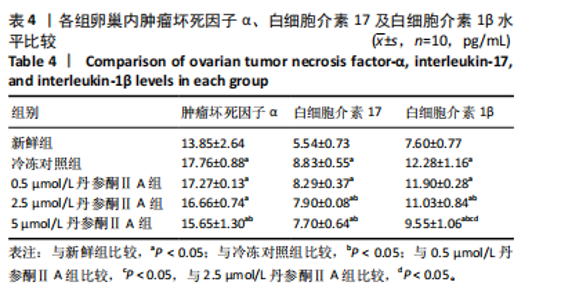
巢内超氧化物歧化酶、过氧化氢酶活性及丙二醛水平均得到一定程度的改善,并且以5 μmol/L丹参酮ⅡA组改善更为显著。表明在低温冻存中添加丹参酮ⅡA能改善低温冻存卵巢组织的氧化应激损伤。 2.3 各组卵巢内肿瘤坏死因子α、白细胞介素17及白细胞介素1β水平比较 卵巢组织经低温冻存后出现的炎症反应也是导致其活性降低的因素之一,其中肿瘤坏死因子α、白细胞介素17及白细胞介素1β是重要的炎症因子指标。如表4所示,与新鲜组相比,其他4组卵巢内肿瘤坏死因子α、白细胞介素17及白细胞介素1β水平均显著升高(P < 0.05);与冷冻对照组相比,不同浓度丹参酮ⅡA组卵巢内肿瘤坏死因子α、白细胞介素17及白细胞介素1β水平均有所降低,并且以5 μmol/L丹参酮ⅡA组上述指标降低最显著。表明低温冻存容易诱发卵巢炎症反应,而丹参酮ⅡA作为冷冻保护剂能降低温冻存卵巢内炎症因子水平,从而实现保护作用。"
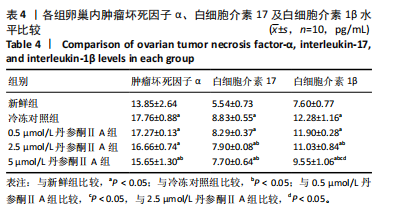
| [1] 谷牧青, Pooja D,阮祥燕.女性生育力保护/保存进展[J].实用妇产科杂志,2021,37(10):721-723. [2] COURBIERE B, ODAGESCU V, BAUDOT A, et al. Cryopreservation of the ovary by vitrification as an alternative to slow-cooling protocols. Fertil Steril. 2006;86(4 Suppl):1243-1251. [3] WARNER RM, BROWN KS, BENSON JD, et al. Multiple cryoprotectant toxicity model for vitrification solution optimization. Cryobiology. 2022;108:1-9. [4] 刘艳丽,申峻涵,杜姗姗,等.玻璃化冷冻和程序化冷冻人卵巢组织的效果[J].实用医学杂志,2021,37(24):3202-3207. [5] 胡方方,李延,崔趁趁,等.人卵巢组织玻璃化冷冻及移植的影响因素分析[J].中国计划生育和妇产科,2023,15(9):20-24. [6] MERCIER A, JOHNSON J, KALLEN AN. Prospective solutions to ovarian reserve damage during the ovarian tissue cryopreservation and transplantation procedure. FFertil Steril. 2024;122(4):565-573. [7] SEOL SI, KANG IS, LEE JS, et al. Taurine Chloramine-Mediated Nrf2 Activation and HO-1 Induction Confer Protective Effects in Astrocytes. Antioxidants (Basel). 2024;13(2):169. [8] MA K, WU HY, WANG SY, et al. The Keap1/Nrf2-ARE signaling pathway is involved in atrazine induced dopaminergic neurons degeneration via microglia activation. Ecotoxicol Environ Saf. 2021;226:112862. [9] 杨璐恺,蒋利刚,崔妍婷,等.槲皮素在羊卵巢组织玻璃化冻存中的卵泡保护及抗氧化作用[J].山东大学学报(医学版),2020,58(9):1-7. [10] 张珦,李惠,章宜芬,等.基于Nrf2/HO-1信号通路研究白藜芦醇在小鼠卵巢冷冻复苏中的保护作用及机制[J].广州中医药大学学报,2023,40(5):1221-1227. [11] CHEN W, YUAN C, LU Y, et al. Tanshinone IIA Protects against Acute Pancreatitis in Mice by Inhibiting Oxidative Stress via the Nrf2/ROS Pathway. Oxid Med Cell Longev. 2020;2020:5390482. [12] YOUM HW, LEE JR, LEE J, et al. Optimal vitrification protocol for mouse ovarian tissue cryopreservation: effect of cryoprotective agents and in vitro culture on vitrified-warmed ovarian tissue survival. Hum Reprod. 2014;29(4):720-730. [13] GOUGEON A. Dynamics of follicular growth in the human: a model from preliminaryresults . Hum Reprod. 1986;1(2):81-87. [14] KOMETAS M, CHRISTMAN GM, KRAMER J, et al. Methods of Ovarian Tissue Cryopreservation: Is Vitrification Superior to Slow Freezing?-Ovarian Tissue Freezing Methods. Reprod Sci. 2021;28(12):3291-3302. [15] RAMOS L, GALBINSKI S, NACUL A, et al. Detailed Morphological Analysis of Cryoinjury in Human Ovarian Tissue Following Vitrification or Slow Freezing. Reprod Sci. 2022,29(8):2374-2381. [16] 屈媛,王婷,付慧婕,等.丹参有效成分及药理作用研究进展[J].辽宁中医药大学学报,2024,26(9):172-176. [17] FANG ZY, ZHANG M, LIU JN, et al. Tanshinone IIA: A Review of its Anticancer Effects. Front Pharmacol. 2020;11:611087. [18] SHERAWAT K, MEHAN S. Tanshinone-IIA mediated neuroprotection by modulating neuronal pathways. Naunyn Schmiedebergs Arch Pharmacol. 2023;396(8):1647-1667. [19] ROTH A, ZHAO P, SOUKUP ST, et al. Chemical Stability and Bioactivity of tanshinone I, tanshinone IIA, cryptotanshinone and dihydrotanshinone in in vitro test systems. Toxicol Lett. 2023;375:21-28. [20] CARPI S, QUARTA S, DOCCINI S, et al. Tanshinone IIA and Cryptotanshinone Counteract Inflammation by Regulating Gene and miRNA Expression in Human SGBS Adipocytes. Biomolecules. 2023; 13(7):1029. [21] YANG C, MU Y, LI S, et al. Tanshinone IIA: a Chinese herbal ingredient for the treatment of atherosclerosis. Front Pharmacol. 2023;14:1321880. [22] 秦文秀,许军峰,杨婷,等.丹参酮ⅡA治疗缺血性脑卒中后神经损伤的信号通路研究进展[J].中国临床药理学与治疗学,2023,28(6): 705-713. [23] 杨芳,高素文,刘旋,等.丹参酮ⅡA通过调控p38MAPK/NF-κB信号通路减轻糖尿病雄性大鼠生殖损伤实验研究[J].陕西医学杂志, 2024,53(5):610-615. [24] 姚兴凤,陆清芳,许常龙.抗氧化剂在卵巢组织玻璃化冷冻保存中的研究进展[J].中国妇幼保健,2024,39(5):958-961. [25] NAJAFI A, ASADI E, BENSON JD. Comparative effects of a calcium chelator (BAPTA-AM) and melatonin on cryopreservation-induced oxidative stress and damage in ovarian tissue. Sci Rep. 2023;13(1): 22911. [26] 李扬璐,阮祥燕,程姣姣,等.抗氧化剂联合应用优化人卵巢组织冻融效果的研究[J].首都医科大学学报,2021,42(4):526-532. [27] SHIROMA ME, DAMOUS LL, COTRIM FP, et al. Pretreatment with melatonin improves ovarian tissue cryopreservation for transplantation. Reprod Biol Endocrinol. 2021;19(1):17. [28] ÑAUPAS L, BRITO D, DE SOUZA SS, et al. Alpha Lipoic Acid Supplementation Improves Ovarian Tissue Vitrification Outcome: An Alternative to Preserve the Ovarian Function of Morada Nova Ewe. Reprod Sci. 2021;28(11):3109-3122. [29] 张海云,韩伟东,刘海梅,等.丹参酮ⅡA对急性肺损伤小鼠炎症因子和氧化应激水平的影响[J].解剖学研究,2020,42(6):491-495. [30] 蒋丽,芮燕君,戴佳琪,等.丹参酮IIA对过氧化氢诱导的人晶状体上皮细胞凋亡和氧化应激的影响[J]. 眼科新进展,2021,41(9):838-842. [31] 蒋诗敏,张珂嘉,周泰,等.丹参酮ⅡA抑制氧化应激减轻人脐静脉内皮细胞损伤[J].徐州医科大学学报,2021,41(4):235-240. [32] 杨恒,张晶,罗明建,等.丹参酮Ⅱ_A磺酸钠注射液联合奥拉西坦对卒中后认知障碍患者认知功能、血清炎性因子和氧化应激指标的影响[J].药物评价研究,2021,44(7):1478-1482. [33] 黄约诺,叶威,郑青秀,等.丹参酮ⅡA对脓毒症肺损伤大鼠氧化应激的影响[J].浙江临床医学,2022,24(10):1430-1432. [34] 李洁,毛宇,蒋可欣,等.丹参酮ⅡA通过改善线粒体功能和氧化应激减轻大鼠认知障碍[J].华东理工大学学报(自然科学版),2021, 47(1):48-57. [35] LI Y, HU Y, ZHU S, et al. Protective Effects of Reduced Glutathione and Ulinastatin on Xeno-transplanted Human Ovarian Tissue Against Ischemia and Reperfusion Injury. Cell Transplant. 2021;30: 963689721997151. [36] 丁维,钟立仁,张海波,等.丹参酮ⅡA磺酸钠对高脂血症勃起功能障碍大鼠 Nrf2/HO-1通路及勃起功能的影响[J].陕西中医,2020, 41(11):1520-1523+1538. [37] 耿银萍,程志杰,郝艳超,等.丹参酮IIA上调Nrf2/HO-1信号通路减轻海马神经元氧糖剥夺/复糖复氧损伤[J].微循环学杂志,2024, 34(2):12-18. [38] 秦智,周敏.丹参酮Ⅱ_A通过Nrf2信号通路抑制肝组织铁死亡对非酒精性脂肪肝大鼠肝脏的保护作用[J].中国中药杂志,2024, 49(6):1611-1620. [39] FU K, FENG C, SHAO L, et al. Tanshinone IIA exhibits anti-inflammatory and antioxidative effects in LPS-stimulated bovine endometrial epithelial cells by activating the Nrf2 signaling pathway. Res Vet Sci. 2021;136:220-226. [40] LI H, WU M, GUO C, et al. Tanshinone IIA Regulates Keap1/Nrf2 Signal Pathway by Activating Sestrin2 to Restrain Pulmonary Fibrosis. Am J Chin Med. 2022;50(8):2125-2151. |
| [1] | Zhao Jiyu, Wang Shaowei. Forkhead box transcription factor O1 signaling pathway in bone metabolism [J]. Chinese Journal of Tissue Engineering Research, 2025, 29(9): 1923-1930. |
| [2] | He Guanghui, Yuan Jie, Ke Yanqin, Qiu Xiaoting, Zhang Xiaoling. Hemin regulates mitochondrial pathway of oxidative stress in mouse chondrocytes [J]. Chinese Journal of Tissue Engineering Research, 2025, 29(6): 1183-1191. |
| [3] | He Bo, Chen Wen, Ma Suilu, He Zhijun, Song Yuan, Li Jinpeng, Liu Tao, Wei Xiaotao, Wang Weiwei, Xie Jing . Pathogenesis and treatment progress of flap ischemia-reperfusion injury [J]. Chinese Journal of Tissue Engineering Research, 2025, 29(6): 1230-1238. |
| [4] | Lu Ranran, Zhou Xu, Zhang Lijie, Yang Xinling. Dimethyl fumarate alleviates nerve damage in a mouse model of Parkinson’s disease [J]. Chinese Journal of Tissue Engineering Research, 2025, 29(5): 989-994. |
| [5] | Sima Xinli, Liu Danping, Qi Hui. Effect and mechanism of metformin-modified bone marrow mesenchymal stem cell exosomes on regulating chondrocytes [J]. Chinese Journal of Tissue Engineering Research, 2025, 29(36): 7728-7734. |
| [6] | Zhang Xiaoyu, Wei Shanwen, Fang Jiawei, Ni Li. Prussian blue nanoparticles restore mitochondrial function in nucleus pulposus cells through antioxidation [J]. Chinese Journal of Tissue Engineering Research, 2025, 29(34): 7318-7325. |
| [7] | Li Tangbo, Song Diyu, Hao Guobing, Zhang Shuming, Zhu Zexing. Quantitative analysis on effect of dimethyl sulfoxide penetration in cryopreservation of rabbits’ severed hindlimb [J]. Chinese Journal of Tissue Engineering Research, 2025, 29(34): 7326-7332. |
| [8] | Su Yongkun, Sun Hong, Liu Miao, Yang Hua, Li Qingsong. Development of novel antioxidants and antioxidant combination carried by nano-hydrogel systems in treatment of intervertebral disc degeneration [J]. Chinese Journal of Tissue Engineering Research, 2025, 29(34): 7376-7384. |
| [9] | Wu Qingyun, Su Qiang. Antioxidant nanomedicine-mediated targeted therapy for myocardial ischemia-reperfusion injury [J]. Chinese Journal of Tissue Engineering Research, 2025, 29(34): 7431-7438. |
| [10] | Tian Yushi, Fu Qiang, Li Ji . Bioinformatics identification and validation of mitochondrial genes related to acute myocardial infarction [J]. Chinese Journal of Tissue Engineering Research, 2025, 29(31): 6697-6707. |
| [11] | Zhou Ying, Tian Yong, Zhong Zhimei, Gu Yongxiang, Fang Hao. Inhibition of tumor necrosis factor receptor associated factor 6 regulates mTORC1/ULK1 signaling and promotes autophagy to improve myocardial injury in sepsis mice [J]. Chinese Journal of Tissue Engineering Research, 2025, 29(30): 6434-6440. |
| [12] | Zhang Xin, Guo Baojuan, Xu Huixin, Shen Yuzhen, Yang Xiaofan, Yang Xufang, Chen Pei. Protective effects and mechanisms of 3-N-butylphthalide in Parkinson’s disease cell models [J]. Chinese Journal of Tissue Engineering Research, 2025, 29(30): 6466-6473. |
| [13] | Zhang Songjiang, Li Longyang, Zhou Chunguang, Gao Jianfeng. Central anti-inflammatory effect and mechanism of tea polyphenols in exercise fatigue model mice [J]. Chinese Journal of Tissue Engineering Research, 2025, 29(30): 6474-6481. |
| [14] | Sun Rongyan, Xu Luchun, Jiang Guozheng, Song Jiawei, Ma Yukun, Fan Jiaojiao, Wang Guanlong, Yang Yongdong, Yu Xing. Du Meridian electroacupuncture inhibits ferroptosis and promotes neurorepair in rats with acute cervical spinal cord injury [J]. Chinese Journal of Tissue Engineering Research, 2025, 29(29): 6228-6238. |
| [15] | Chen Lijuan, Gao Xinxue, Wu Jin, Du Ying, Lyu Meijun, Sui Guoyuan, Jia Lianqun, Pan Guowei. Construction and evaluation of spleen-deficiency hyperlipidemia mouse models [J]. Chinese Journal of Tissue Engineering Research, 2025, 29(29): 6237-6242. |
| Viewed | ||||||
|
Full text |
|
|||||
|
Abstract |
|
|||||
